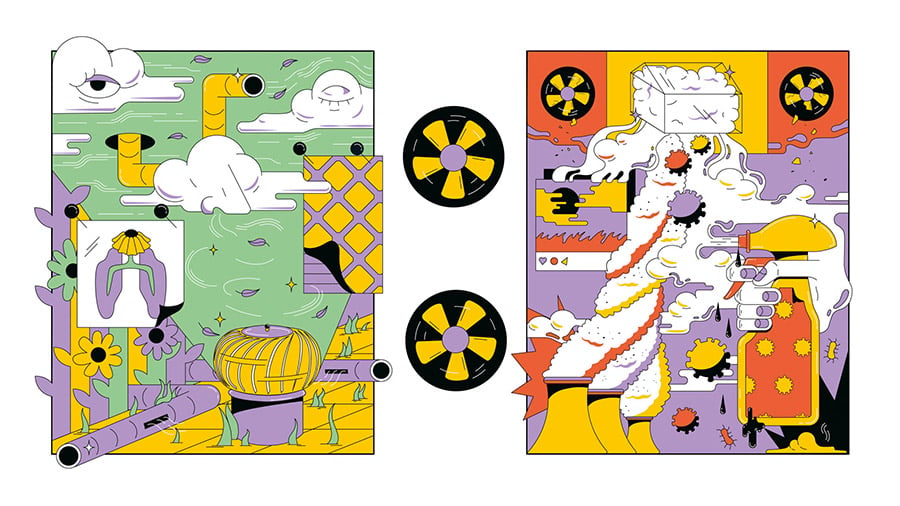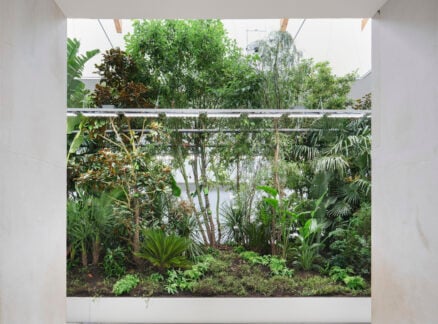
December 21, 2020
After 2020, Designing For Indoor Air Quality Will Never Be the Same
In a year marked by airborne pathogens and wildfires, how should HVAC systems evolve to protect us from dangers lurking both inside and out?

The calls started coming in immediately after lockdown, clients from as far as two decades back resurfacing to ask whether their HVAC systems needed updating, and a more painful underlying question: If someone breathes the air inside my building today, could they die?
“Everyone across the industry was nervous,” says Dave Kurten, senior vice president for building engineering at HDR, the architecture firm with the world’s highest health-care billings. “None of us knew how severe this was going to be. We had to educate ourselves and offer guidance.”
The problem in March (and still, to some degree) was that epidemiologists weren’t certain about how the microbe that causes COVID-19 was traveling. They knew the killer virus liked to hitchhike: It was often floating through enclosed spaces adjoined to respiratory droplets or particulate matter. But what size were those particles? What kind of filter could catch them? Had ventilation systems essentially become disease blowers, machinated super-spreaders?
Kurten and his team had handled airborne pathogens in hospitals and research laboratories before—they knew that a more expensive class of HEPA (high-efficiency particulate air) filters could block some microscopic particles. Filters are rated on a MERV (minimum efficiency reporting value) scale, numbered from 1 to 20. Lower numbers catch the big stuff, like dust or dirt that can clog up machinery. (Maintenance folks sometimes jokingly call these “squirrel filters.”) Ratings from 9 to 12 have long been considered acceptable for most indoor air quality situations, as in offices and apartment buildings. But early on in the pandemic, Kurten says, clients and systems designers started to consider filters up past MERV 13. Was it safer? Perhaps, but Kurten knew it was by no means a surefire solution.
“I can’t just tell you to put a HEPA filter in and be good,” says Kurten. “Changing the filter has repercussions throughout the mechanical system and could have unintended consequences that need to be evaluated by a building owner.”
Case in point: Denser filters tend to slow down airflow, so a higher MERV rating could mean less circulation (degrading a core principle of halting virus spread) or uneven heating and cooling in a building. To compensate, you could increase the “push” of air through the filter with a higher-powered fan, but then energy consumption would jump up. And when a power grid is reliant on fossil fuels, as most of the world’s still are, extra energy expenditure means extra carbon emissions. A short-term and urgent fix for indoor air safety, then, diminishes an even bigger long-term goal: slowing Earth’s dangerous heat spike.

While Kurten and his global team were juggling these competing imperatives, Nathan Stodola, chief engineer of the International WELL Building Institute (IWBI), helped set up a task force on respiratory diseases, convening experts around the world to meet regularly in online forums and brainstorm ways to reduce particle exposure. Suggestions included more queuing marks and protective screens in public spaces, hands-free technology that would save people from having to touch contaminated surfaces, and what seemed like a holy grail to Stodola: a focus on not recirculating indoor air. Since the advent of tight envelopes and inoperable windows, many large buildings completely refresh indoor air only a few times an hour or even in a day. Was it possible, the experts wondered, to evolve HVAC design to (passively or actively) pull in the majority of air in a space from the outdoors? After all, so much of Europe had done it using “heat exchanging” devices that minimize extra energy use. The task force’s work eventually resulted in updates to the WELL Building Standard features, including one that would reward supplying spaces with 100 percent outdoor air.
Then August hit, and the fires. Americans on the West Coast faced the claustrophobic prospect that dangerous particulate matter outdoors was every bit as risky to their lungs as the potential of a COVID-19 infection indoors. There were certain days when the most polluted cities in the world were all in California, as measured by air quality indexes (AQIs). As people in places like Lahore, Delhi, and Beijing know all too well, an AQI over 200 is judged “Very Unhealthy,” even for fit and uncompromised people. As more than 3 million acres of forests went up in smoke this year, AQIs in the West peaked in the “Hazardous” range, well into the 400s.
Brent Bucknum, an Oakland, California–based designer, called it “the confluence of the apocalyptic.”
Bucknum is the founder of an ecology-minded engineering firm called Hyphae Design Lab. He’s been examining how the already-with-us effects of climate change—from hotter and more polluted city air to a wider geographic distribution of pathogens—have the severest cumulative health impacts on communities of color and the least affluent. In his projects, he’s prioritized solutions that draw on natural processes, like installing green walls with a diversity of plants that can filter polluted air, while also adding a sense of community to neighborhoods.
“We have to take a philosophical approach to public health, looking at people as part of ecosystems,” says Bucknum. “Everything is connected and HVAC itself is an ecosystem.”
Bucknum’s proposals for evolving HVAC include more experimentation with a “probiotic approach” rather than the typical antiseptic, kill-all-germs methods. He points to research on biofilters, already used in the poultry and paint industries, that rely on fungi and bacteria (similar to what you’d find in healthy soil) to break down harmful volatile air compounds.
Ben Tranel, a principal at Gensler whose team is working on a mixed-use office park project called CityView in San Jose, California, says they’ve tweaked its design to include plentiful outdoor spaces, MERV 15 filters, and ventilation systems that can adjust to changing outdoor air quality. He sees this moment as a historic impetus for more rapid innovation in sustainable, healthy HVAC products and design practices.
“We need to provide people with healthy environments and a healthy Earth to inhabit,” says Tranel. “There have been other health crises that have caused us to rethink our built-environment infrastructure, and we’ve come out of those situations with an improvement.”
You may also enjoy “With a Circular Economy in Mind, Retailers Are Speaking Out Against ‘Fast Furniture’”
Would you like to comment on this article? Send your thoughts to: [email protected]
Register here for Metropolis’s Think Tank Thursdays and hear what leading firms across North America are thinking and working on today.
Recent Viewpoints
Viewpoints
Sustainability News Updates for Q2 2025





